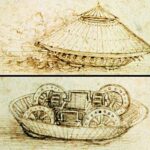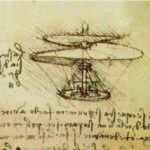Mark I Tank
In the chronicles of military history, the Mark I tank stands tall as a revolutionary invention that forever altered the dynamics of warfare. Born amidst the chaos of World War I, this British innovation was not just a new piece of machinery; it was a symbol of radical change, a testament to human ingenuity in the face of adversity. This steel leviathan was designed to navigate the rutted landscapes and trench networks that characterized the Western Front. Prior to its invention, these trenches, a grim hallmark of World War I, had stymied the armies of both sides, leading to a devastating stalemate.
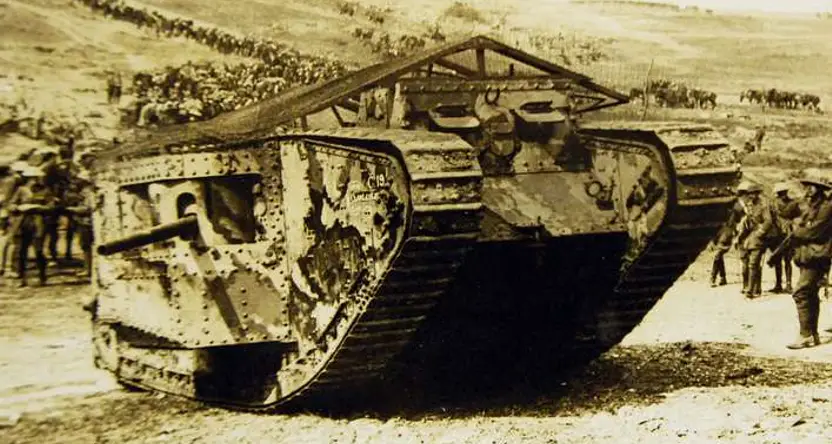
Mark I tank in WW1
However, the introduction of the Mark I tank on 15 September 1916 signified a shift in the tide. Its combination of armored protection, firepower, and all-terrain mobility gave birth to a new era of mechanized warfare, freeing soldiers from the deadly entrapment of trench warfare. The Mark I tank, therefore, became the blueprint for all future tanks, paving the way for successors like the Mark II and Mark IV tanks, right up to the Mark VIII tank. Each iteration, while different in specific design and capabilities, carried forward the legacy of the original Mark I.
The Mark I tank holds a crucial place in the annals of military technology. It demonstrated that necessity, truly, is the mother of invention. In the darkest hours of World War I, it shone as a beacon of hope and marked a profound evolution in how battles would be fought in the years to come. Just as the innovations of Leonardo da Vinci were pivotal in his time, the Mark I tank was, and remains, a watershed in ours.
The Mark I Tank and WW 1
World War I (WW1) saw the emergence of new technologies that forever changed the nature of warfare, among which the Mark I tank was undoubtedly the most revolutionary. The brutal stalemate of trench warfare demanded an innovative solution, and in response, the Mark I tank was born.
The Role of Mark I Tank in WW1
When the Mark I tank was introduced to the battlefield in 1916, it brought an abrupt end to the age of static warfare. The tank, with its caterpillar track design, could navigate the treacherous terrain of the battlefields, clearing paths over trenches and through barbed wire defenses. This ability, coupled with its heavy armor and artillery, made it an intimidating force against the German lines.
The Mark I tank had the element of surprise on its side. Its debut on the battlefield at the Battle of Flers-Courcelette caught the Germans off guard, leaving them ill-prepared to counter this new form of warfare. The tank’s psychological impact was as significant as its physical one, shaking the resolve of the German forces and signaling the beginning of a shift in the momentum of the war.
The Capabilities of the Mark I Tank
The Mark I tank was a force to be reckoned with. Its maximum speed was around 3.7 mph on flat terrain, a slow but steady pace that mirrored the grim determination of the British forces. Despite its lumbering pace, the tank’s unique ability to traverse difficult terrain made it a formidable tool on the battlefield.
The tank’s firepower was equally impressive. The Mark I was armed with two 6-pounder guns and multiple machine guns, making it a mobile fortress capable of delivering a devastating blow to enemy fortifications. Its armored shell could withstand small arms fire and shrapnel, protecting the crew within.
This combination of robust defenses and potent offensive capabilities was unprecedented at the time, and placed the Mark I tank in a league of its own. Just like how Leonardo da Vinci’s inventions broke boundaries in their era, the Mark I tank shattered the conventional wisdom of war, marking a new chapter in military history.
Comparing WW1 Tanks
The evolution of tanks during World War I was a testament to the rapid advancement in military technology, marked by incremental improvements and strategic variations. Among the most significant of these were the British Mark series tanks and the German tanks.
The Mark Series Tanks
| Model | Key Features | Use in Combat |
|---|---|---|
| Mark I | First armored vehicle designed for frontline combat. | Used in World War I |
| Mark II | Slight modifications to the Mark I. Primarily used for training. | No combat usage |
| Mark III | Improved armor protection and better living conditions for the crew. | No combat usage |
| Mark IV | Thicker armor, improved fuel systems, and more reliable weaponry. | Used in World War I |
| Mark V | New transmission system for easier control and increased speed. | Used in World War I |
| Mark VI | Designed, but never made it past the prototype stage. | No combat usage |
| Mark VIII ‘Liberty’ | Thicker armor, more powerful engine, a collaborative effort with America. | No combat usage during World War I, but used later |
The German WW1 Tank
Germany’s response to the British Mark series came in the form of the A7V. Compared to the Mark I tank, the A7V was significantly faster, able to reach speeds of up to 9 mph. It was also equipped with a main gun and six machine guns, offering a formidable mix of firepower.
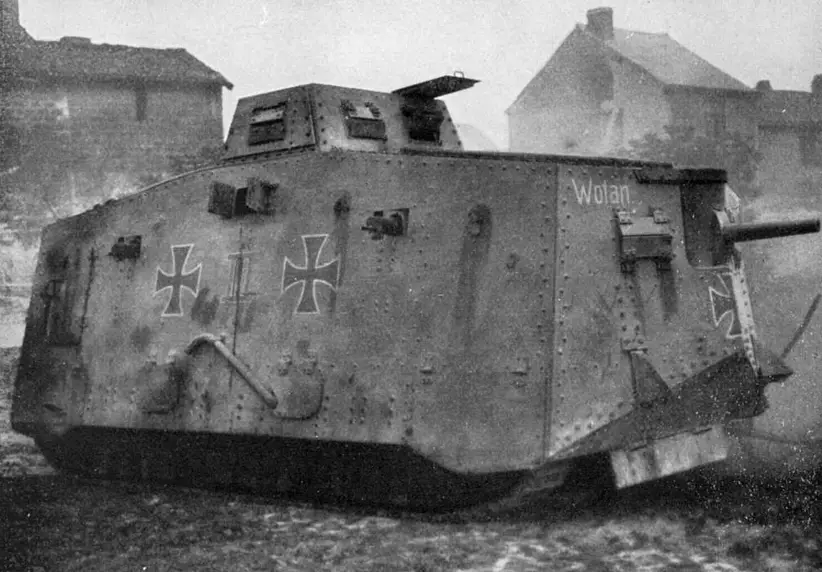
German A7V tank
However, where the Mark I and its successors had the advantage was in their ability to traverse difficult terrain due to their caterpillar track design. The A7V, in contrast, struggled with trenches and uneven landscapes.
From the imposing Mark I tank to the late arrival of the Mark VIII, each iteration reflected a continuous process of learning and adaptation. They stood as symbols of the drive for innovation, much like the inventions of Leonardo da Vinci that pushed the boundaries of what was thought possible. Similarly, the German A7V was a clear testament to the speed with which nations adapted to the changing nature of warfare during this period.
Looking at Tanks Throughout History
The course of history has seen tanks evolve from the rudimentary designs of World War I to the technologically advanced machines of today. While there have been many formidable tanks, there have also been those that were less successful on the battlefield.
The Weakest Tanks
In the realm of WW1 tanks, the French FT-17 often comes to mind when discussing weaker models. While revolutionary in its own right for introducing the classic turret design, the FT-17 was lightly armored and armed only with a machine gun or a light cannon, making it less effective against fortified positions and virtually defenseless against other tanks.
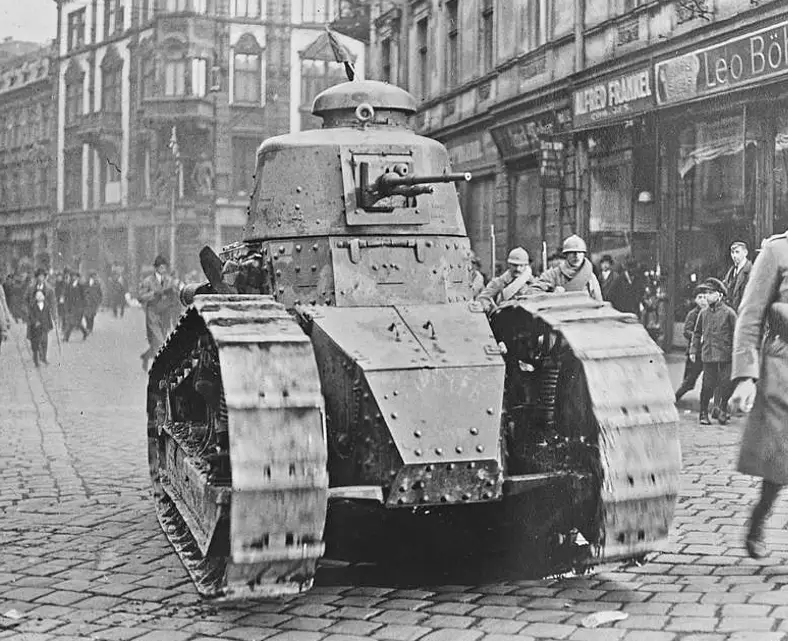
French FT-17 tank
Beyond World War I, the Italian L3/35 of World War II is often cited as one of the weakest tanks ever produced. Despite its impressive mobility, the L3/35 was severely under-armored and under-gunned, with its twin machine guns providing little threat to enemy tanks or fortified positions.
The Most Effective Tanks
When it comes to effectiveness, the T-34, a Soviet tank of World War II, is often hailed as one of the best. It combined a robust design with wide tracks (ideal for the Eastern Front’s harsh terrain), a powerful 76.2mm gun, decent speed, and sloped armor that increased the tank’s defensive capabilities. The T-34 was a testament to the effectiveness of straightforward design and mass production, and it played a crucial role in the Soviet Union’s defensive and offensive operations.
Modern tanks in the post-WWII era, the T-72 stands out as one of the Soviet Union’s most effective tanks. With over 20,000 units produced since its introduction in the late 1960s, the T-72 boasts a powerful 125mm smoothbore gun, composite armor, and a compact design, making it one of the most widely used tanks in history.
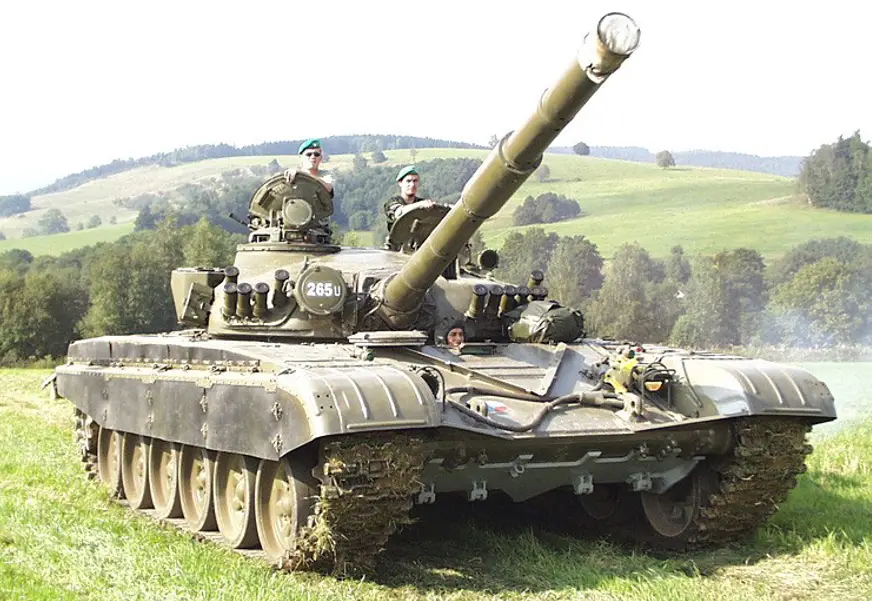
T-72 tank
The analysis of tank designs, from the weakest to the most effective, mirrors the trajectory of human innovation. Each model, regardless of its success or failure, represents a stepping stone towards progress, much like how the creations of Leonardo da Vinci helped shape the future of human invention.
Conclusion
The dawn of mechanized warfare was symbolized by the advent of the Mark I tank in World War I. As the first armored vehicle designed for frontline combat, it marked a seismic shift in the tactics and strategy of warfare. The Mark I tank was not just a response to the specific challenges of trench warfare; it was a blueprint for the future.
The significance of the Mark I tank cannot be overstated. It laid the groundwork for successive generations of tanks, starting from the Mark II to the Mark VIII and beyond. It influenced the design of the German WW1 tank and was a precursor to the formidable tanks of World War II.
In the broader context of human history, the development of the Mark I tank shares parallels with the evolution of Leonardo da Vinci’s inventions. Just as da Vinci’s creations pushed the boundaries of what was considered possible in his time, the Mark I tank expanded the horizons of military strategy, forever altering the landscape of warfare. It stands as a testament to the boundless potential of human innovation when faced with the most formidable challenges.
